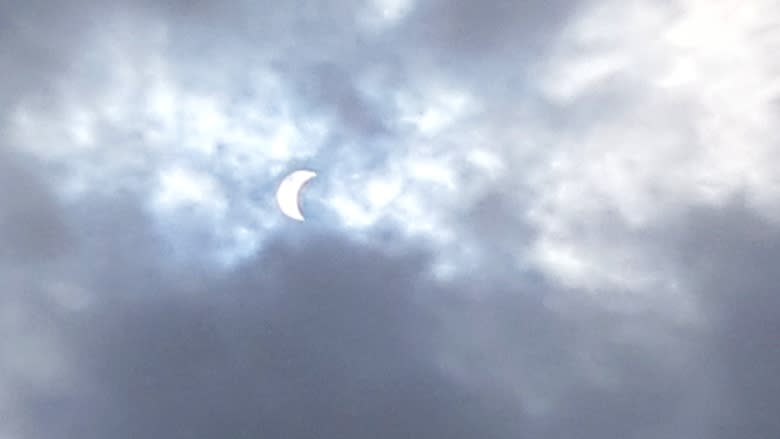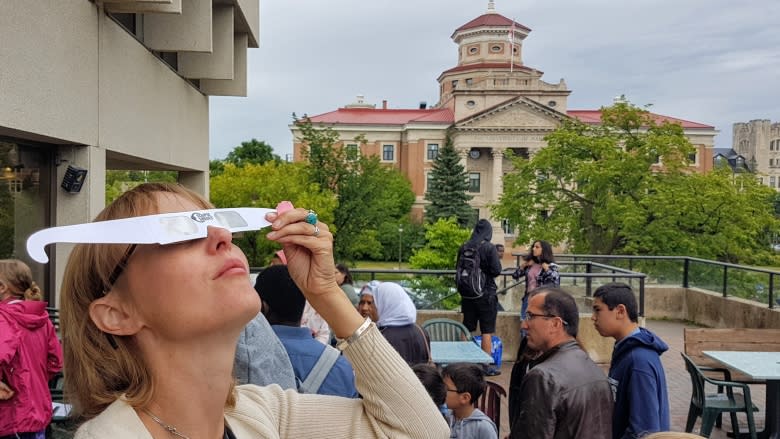'Worth the wait': Eclipse makes appearance in Winnipeg despite clouds
The solar eclipse briefly broke through clouds Monday giving sky-watchers the glimpse they were waiting for.
While the total solar eclipse was only visible in the United States, in Manitoba, people could still see a partial version — a sliver of sunlight peeking out in a crescent shape behind the moon.
Winnipeg's Planetarium was packed with families eager to see a live feed from NASA of the total solar eclipse. Solar-safe telescopes were also on hand to give people a closer view of the celestial event in Winnipeg.
"We thought it was really important for our kids to see it when they were around the same age we were," said Phil Elchitz, who with his wife Cindy Elchitz, brought his two kids to the Planetarium to see the partial eclipse.
The last total solar eclipse in Winnipeg was in 1979.
Monday's eclipse was a big deal because its path was almost entirely on land and visible to so many people, said Malaika Brandt-Murenzi, a science gallery animator with the Manitoba Museum.
"It's probably going to be the most viewed eclipse in human history," she said.
The next total solar eclipse that will be visible from near Winnipeg will be in 2263, said Brandt-Murenzi.
Sun breaks through clouds
Environment Canada had warned cloud cover in Winnipeg and southeast Manitoba would block Monday's show.
But as it turned out, breaks in the cloud gave Manitobans a brief chances to see the eclipse.
"This is the way Mother Nature does things," said Scott Young of the Manitoba Museum. "Sometimes you get beautiful clear skies for an event, and sometimes you get clouds. You just have to persevere and it's all part of observing the universe."
The eclipse began in Brandon at 11:36 a.m., with maximum eclipse at 12:53 p.m. and ended at 2:11 p.m.
The eclipse in Winnipeg began at 11:40 a.m., with maximum eclipse at 12:57 p.m. and ended at 2:15 p.m.
'Worth the wait'
While viewers in Winnipeg were only treated to a partial eclipse, Manitoban David Swayze and his family travelled to Wyoming to get the total experience.
Swayze was nine in 1979 when the last total solar eclipse was visible from Manitoba. He lived in Brandon and should have had a front-row seat, but his parents sent him to school that day, and students weren't allowed to go outside to watch.
"I watched it on a 12-inch black-and-white television in a darkened classroom, which really doesn't give you the full flavour of what I experienced today," Swayze said Monday in an interview on CBC Manitoba's Up To Speed.
"I spent 38 years trying to make up for it and I was able to do it today, so I'm pretty thrilled," he said.
Swayze and his family camped in Lusk, Wyo., Monday morning. He estimated there were hundreds of thousands of others there to see the eclipse, which lasted nearly two minutes in that location.
"You start to notice it getting dark. I would say about 15, 20 minutes before totality, it is noticeably starting to get dark. Then it gets cool. Even my wife Jane noticed, she said, 'You know, it's getting cold out,'" he said.
"And then all of a sudden you're in darkness, and everybody's oohing and ahhing and screaming and it's really something to see."
Swayze said it was an emotional experience nearly 40 years in the making.
"The horizon, it's like a sunrise," he said. "It's dark above you, you see the stars. And then the sunrise around you — it's really something."



